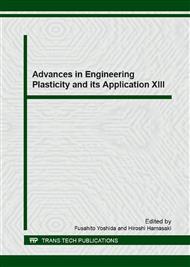[1]
I. Bantounas, D. Dye, T.C., Lindley, The effect of grain orientation on fracture morphology during high-cycle fatigue of Ti-6Al-4V, Acta Materialia. 57 (2009) 3584-3595.
DOI: 10.1016/j.actamat.2009.04.018
Google Scholar
[2]
M.R. Bache, A review of dwell sensitive fatigue in titanium alloys: the role of microstructure, texture and operating conditions, International Journal of Fatigue. 25 (2003) 1079-1087.
DOI: 10.1016/s0142-1123(03)00145-2
Google Scholar
[3]
F. Bridier, D.L. McDowell, P. Villechaise, J. Mendez, Crystal plasticity modeling of slip activity in Ti-6Al-4V under high cycle fatigue loading, International Journal of Plasticity. 25 (2009) 1066-1082.
DOI: 10.1016/j.ijplas.2008.08.004
Google Scholar
[4]
J.R. Mayer, D.L. McDowell, A three-dimensional crystal plasticity model for duplex Ti-6Al-4V, International Journal of Plasticity. 23 (2007) 1475-1485.
DOI: 10.1016/j.ijplas.2006.11.006
Google Scholar
[5]
S. Osterstock, C. Robertson, M. Sauzay, S. Degallaix, V. Aubin, Prediction of the scatter of crack initiation under high cycle fatigue, Key Engineering Materials. 345-346 (2007) 363-366.
DOI: 10.4028/www.scientific.net/kem.345-346.363
Google Scholar
[6]
T. Ohashi, Computer simulation of non-uniform multiple slip in face centered cubic bicrystals, Transactions of the Japan Institute of Metals. 28 (1987) 906-915.
DOI: 10.2320/matertrans1960.28.906
Google Scholar
[7]
T. Ohashi, Numerical modelling of plastic multislip in metal crystals of f. c. c type, Philosophical Magazine A. 70 (1994) 793-803.
DOI: 10.1080/01418619408242931
Google Scholar
[8]
T. Mayama, T. Ohashi, R. Kondou, Geometrically necessary dislocation structure organization in FCC bicrystal subjected to cyclic plasticity, International Journal of Plasticity. 25 (2009) 2122-2140.
DOI: 10.1016/j.ijplas.2009.02.001
Google Scholar
[9]
T. Ohashi, R. Kondou, Evolution of dislocation patterns in a tricrystal model subjected to cyclic loading, Philosophical Magazine. 93 (2013) 366-387.
DOI: 10.1080/14786435.2012.721017
Google Scholar
[10]
R. Kondou, T. Ohashi, Multi-body-interaction of crystal grains in compatible-type tricrystals under tensile loading and formation of disclination-type displacement field, Transactions of the Japan Society of Mechanical Engineers Series A. 72 (2005).
DOI: 10.1299/jee.3.295
Google Scholar
[11]
R. Hill, Generalized constitutive relations for incremental deformation of metal crystals by multislip, Journal of the Mechanics and Physics of Solids. 14 (1966) 95-102.
DOI: 10.1016/0022-5096(66)90040-8
Google Scholar
[12]
E.S. Fisher, C.J. Renken, Single-crystal elastic moduli and the hcp → bcc transformation in Ti, Zr, and Hf, Physical Review. 135 (1964) 482-494.
DOI: 10.1103/physrev.135.a482
Google Scholar


